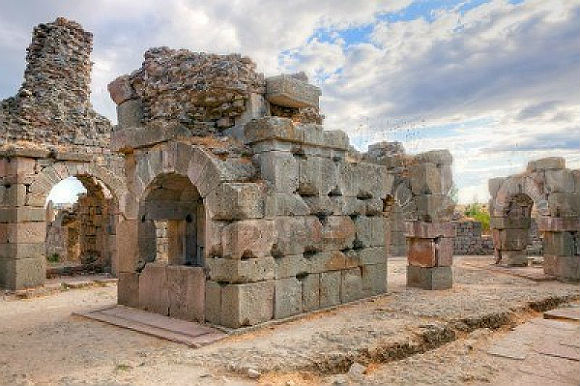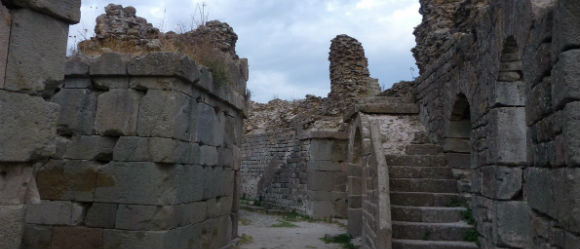An ancient medical centre, the Asclepion was founded by Archias, a local who had been cured at the Asclepion of Epidaurus (Greece). Treatments included mud baths, the use of herbs and ointments, enemas and sunbathing. Diagnosis was often by dream analysis.
Pergamon‘s centre came to the fore under Galen (AD 131–210), who was born here and studied in Alexandria, Greece and Asia Minor before setting up shop as physician to Pergamum’s gladiators. Recognised as perhaps the greatest early physician, Galen added considerably to knowledge of the circulatory and nervous systems, and also systematised medical theory. Under his influence, the medical school at Pergamum became renowned. His work was the basis for Western medicine well into the 16th century.
The Asclepion is 2km uphill from the town centre as the crow flies (but it’s a winding road), signposted from Cumhuriyet Caddesi just north of the tourist office and PTT. A second road runs from Böblingen Pension, southwest of town. It’s closed to motorists and we don’t recommend walking it, as it passes through a large military base; if you do, be off it by dusk and don’t take photos.
A Roman bazaar street, once lined with shops, leads from the entrance to the centre, where you’ll see the base of a column carved with snakes, the symbol of Asclepios (Aesculapius), god of medicine. Just as the snake sheds its skin and gains a ‘new life’, so the patients at the Asclepion were supposed to ‘shed’ their illnesses. Signs mark a circular Temple of Asclepios, a library and, beyond it, a Roman theatre.

Underground access to the Temple of Telesphorus in Roman city Pergamon. The Asklepion of Pergamon was something in between a sanctuary and a spa resort.
You can take a drink from the sacred well, although the plastic tube out of which the water flows doesn’t look particularly inviting, and pass along the vaulted underground corridor to the Temple of Telesphorus, another god of medicine. Patients slept in the temple hoping that Telesphorus would send a cure or diagnosis in a dream. The names of Telesphorus’ two daughters, Hygeia and Panacea, have passed into medical terminology.
Asclepion,


Aescalepia are healing sanctuaries dedicated to the god Aesculapius that functioned as hospitals. There are around 300 ancient Aescalepia Greek and Roman ruins and this is one of the more complete ones that includes remains of a colonnaded street, Via Tecta (sacred way), the Aesculapius sanctuary, Heroon, incubation rooms, library, porticos, bathing pools, latrines. Of particular importance is the base…
Visiting the Asklepion was amazing and really interesting. It was great having a guide giving us information on the site, as we were told what kinds of treatments were offered and what the buildings and ruins were originally.
The complete visit is facinating… just go and visit!
Wewalked from bergama central to the Asklepion on a Sunday morning and practically had the place to ourselves. Take a good guidebook to the site, with a mapm abnd plenty of time to wander, discoverm think. . It is large, in relatively good repair, and a visual depiction of the philosophy and development of "medicine" by Galen the Physician. I…
The Asclepion (Asklepieion) of Pergamum was once the world's most famous ancient medical center, and is the second-most important site in modern Bergama. The Temple of Asclepios, remains of the library, agora columns and intimate theatre are well signposted.
My family has interests in the medical profession so this was a good history lesson. The 15 TRY seemed a bit high for this attraction. For a family definitely too high a price.
Galen the physician practiced here and the day that I was there with my tour guide it was peaceful and quiet. The hospital practiced what would now be called holistic methods of healing and one can see how the setting would add to that. Crowds were small that day and I think that if you are in Bergama you should…
Asklepion was amazing and really interesting.
The ruins of Pergamon's Asklepieion are in a separate location but well worth the short trip over there. Most tourists don't bother but it was nice to have the place to ourselves and it was so interesting to explore what was the center for treatment of psychological disorders in Ancient Roman times.
The Asklepion in Pergamum is much better preserved than the similar structure found in Epidaurus in Greece.
Essentially a glorified Health Spa, patients would come here to pray to the God Asklepius to be cured or for good health. Treatment included bathing, poetry reading and hallucinagenics in a darkened room.
Anyone who was terminally ill was turned away as Asklepius…